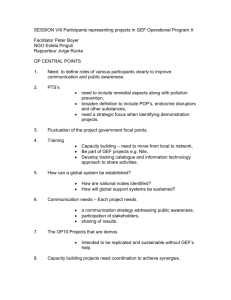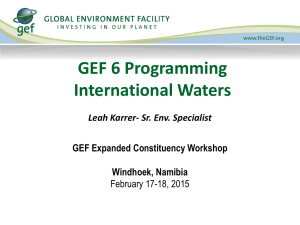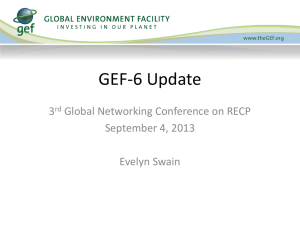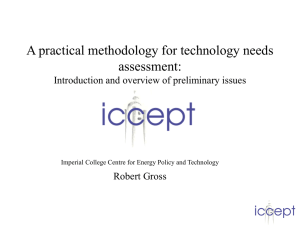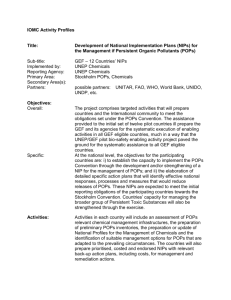Global Strategy and Investments in E-wastes Ibrahima SOW
advertisement
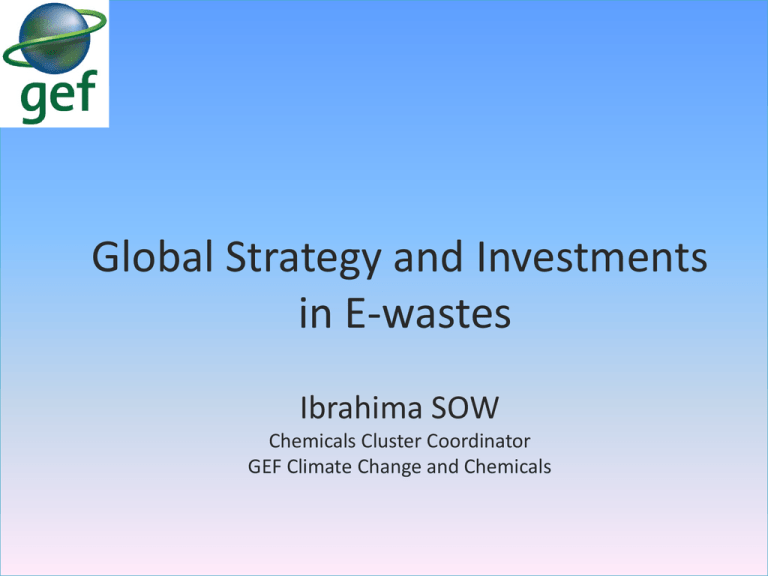
Global Strategy and Investments in E-wastes Ibrahima SOW Chemicals Cluster Coordinator GEF Climate Change and Chemicals GEF Chemicals Cluster –Areas of Work The GEF Chemicals Focal Area includes POPs, ODS, Mercury and Sound Chemicals Management for increased coherence. Phase out of Persistent Organic Pollutants – Stockholm Convention Phase out of Ozone Depleting Substance, specifically to Countries with Economies in Transition – Montreal Protocol Pilot activities on mercury – to support and inform ongoing negotiations of an agreement on Mercury Pilot activities on chemicals of Global Concern – Related to the Objectives of the Strategic Approach to International Chemicals Management (SAICM), including E-waste, chemicals in products and lead in paint. Overview of GEF Investment on POPs Since 2001 the GEF has committed US$ 695 million to projects in the POPs focal area and leveraged some US$ 1.701 billion in cofinancing from partners in the public and private sectors, bringing the total value of the GEF POPs portfolio to over US$2.4 billion. To date, the GEF has financed NIPs development projects for all developing countries Parties requiring support. So far 108 Parties have already submitted their NIPs to the Secretariat of the Stockholm Convention. The GEF also financed 109 post-NIP projects for the implementation of the Convention. (see details in Chart 1&2) GEF Funding of Post-NIP Activities to Address POPs The GEF began supporting Stockholm Convention implementation projects (on the ground projects based on NIPs) in 2002. Over the years the GEF has provided approximately US$ 479 million in direct investments to address global POPs challenges. These GEF investments have leveraged another US$ 1.24 billion in co-financing from national and local governments, private sector organizations, and other stakeholder. GEF 5 funding for Chemicals Management • $425 million allocated to chemicals. The distribution of resources is as follows: • POPs: $375 million • Ozone: $25 million • Sound chemicals management and mercury reduction: $25 million 5 Chemicals strategy for E-waste Objectives Answer the need from SAICM to have GEF working on emerging policy issues including e-waste; Maximize GEF’s comparative advantage in co-reduction of POPs, ODS, and other chemicals of global concern; Facilitate efforts on the synergy among the Basel, Rotterdam and the Stockholm Conventions, and contribute to sustainable development in terms of resources recovering and recycling. 6 Program components ASIA Focus on countries, which produce significant amounts of ewaste and import from abroad or generate domestically increasing volume of e-waste. Project includes components on: •Demonstrating the introduction of clean technology to reduce environmentally hazardous contents in products; •Piloting/Replicating successful e-waste management practices including environmentally sound collection, storage, refurbishment, recycling, and disposal of e-waste in target countries. 7 Program components AFRICA •Project to build on the newly completed World Bank project in Ethiopia, which has assisted in training and establishment a refurbishment and demanufacturing facility in Akaki. •Involvement of BCRCs to mobilize participation and contribution from other interested countries. The ultimate aim is to pave the way for addressing e-waste issues and promote sustainable recycling efforts in Africa. 8 Program components Private sector participation has been confirmed from Nokia and Dell through USEPA. The envisaged GEF project includes components on: •Mainstreaming e-waste management into national legislation, regulation and standards; •Piloting/Replicating successful e-waste management practices including environmentally sound collection, storage, refurbishment, recycling, and disposal of e-waste in target countries. 9 Program components GRULAC Interest expressed by Agencies in working with BCRC in South America to develop a regional project involving Argentina, Uruguay and other interested countries. The project envisions using Argentina as the entry point to revise regulatory scheme, improve refurbishment scheme, and transform the informal sector in the region. BCRC will participate as the platform for replication. The envisaged GEF project includes components on: 10 Program components GRULAC Upgrading existing domestic hazardous waste facilities with proper environmental licenses; Promotion of local recycling and environmentally sound management of used and end-of-life electronic equipment to maximize resource recovery in the region. 11 GEF Finance of Chemicals Management GEF5 has programmed 10 million USD for sound chemicals management to cover the following issues: •E-waste – Properly designed e-waste projects should take into account mercury and POPs issues as relevant. •Products containing chemicals of global concern, consistent with SAICM •Lead in paint Potential Synergies with other Focal areas In GEF 5 more synergy in projects is encouraged in order to achieve greater impact. In this regard, Multi Focal Area, or integrated chemicals and waste projects that countries may wish to consider would include: Dealing with POPs, e-waste, mercury, lead and improving waste management. Mercury Lamps and other waste products in Building/Lighting efficiency projects Climate Mitigation projects in Coal Power Plants which include Mercury Mitigation from the same emission streams. Mercury and POPS reduction in Medical waste Recycling processes and metal recovery POPs and ODS co- destruction/Energy efficiency Contact Information Robert K. Dixon, Team Leader, Climate Change and Chemicals rdixon1@thegef.org Ibrahima Sow, Chemicals Cluster Coordinator isow@theGEF.org Anil Sookdeo, Environmental Specialist asookdeo@thegef.org Evelyn Swain, Environmental Specialist eswain@thegef.org Jie Pan, Junior Professional Associate jpan@thegef.org Shintaro Fujii, Intern, sfujii@thegef.org GEF Task Force Meeting during COP5
